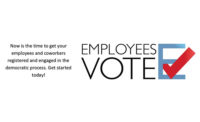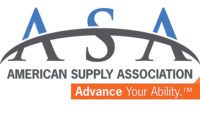In last month’s ASA News section I discussed several of the slim margins that elections have been decided by — some as few as a few hundred votes at the congressional level.
Without question, every vote counts. Four years ago during the 2012 elections, almost one in four eligible voters did not vote. One in eight had inaccurate or invalid registrations. How could that be?
The American Supply Association is partnering with others in the business community to present Employee Voter Registration Week. EVRW takes place Sept. 26-30 and is an effort to make a dent in the number of unregistered citizens across the country. During this week, companies and associations such as ASA will join together in an effort to encourage voter registration in the private sector. This initiative won’t tell employees how to vote or who to vote for, but instead aims to serve as a resource to help employers educate their employees about the issues that are important to their industries and provide key deadlines, voter registration and polling location information.
Statistics show each day there are 4.5 billion Facebook “likes” worldwide. There are 157 million daily users of Facebook in the U.S. (and Canada) — let’s say conservatively that 130 million of those are in the U.S. And yet in 2012, according to the official report prepared by the Federal Election Commission, only 129,085,410 voted in the presidential election out of a total of nearly 195 million eligible voters. Do people care more about Facebook than they do about their nation? Do we need to partner with Facebook to get more people to “like” voting?
In 2016, voters can cast their ballot in multiple ways. It’s no longer the mechanical curtain we accompanied our mom or dad into (and as a parent today, I can understand why mom refused to tell me who she voted for. It really is a personal decision). In 2012, only 56.6% of votes cast were done so on Election Day. Others voted by absentee ballot (16.6%), by mail (4.9%), provisional (1.6%), the validity of which is decided after election day, and finally, my favorite, early voting, which 9% of voters took advantage of.
Not only is voting a personal decision, it’s also handled differently in each of the 50 states, typically under the authority of the state’s Secretary of State. According to the National Conference of State Legislatures, more than two-thirds of the states — 37 plus the District of Columbia — offer some sort of early voting, meaning you do need a legitimate excuse to justify your early vote.
Do you have a horrendous commute each day or have to travel out of town for work? That may be a valid excuse in Virginia. Twenty-seven states, including Washington, D.C., offer no-excuse absentee voting. Three states, Oregon, Washington and Colorado, conduct all elections by mail. A ballot is automatically mailed to every registered voter in advance of Election Day and traditional in-person voting precincts are not available. However these states still provide one or more locations for voters to return mail ballots, vote in-person if they would like and receive other voter services.
Never forget the need to go to the polls and most importantly, make sure your registration is up to date and accurate. We may not like who is at the top of the ticket, but that is just one vote in many we’d be escaping if we stayed home on Election Day or didn’t mail in that ballot.
Ballot initiatives always are popular, as is taxing and bonding authority. Remember, you cannot complain if you didn’t cast your vote in favor or opposition of these decisions and the decision-makers. Log on to ASA’s Election Center (located under the Advocacy tab at www.asa.net) to learn who and what initiatives will be on your ballot this fall, where and when you can vote and if still necessary, where you and your peers can register.
Be an active participant in this process and encourage your coworkers to do the same!





